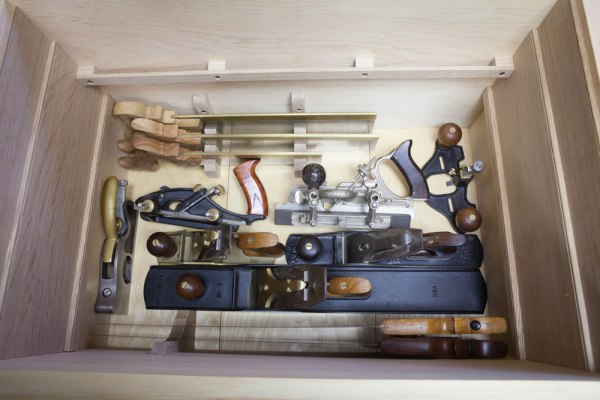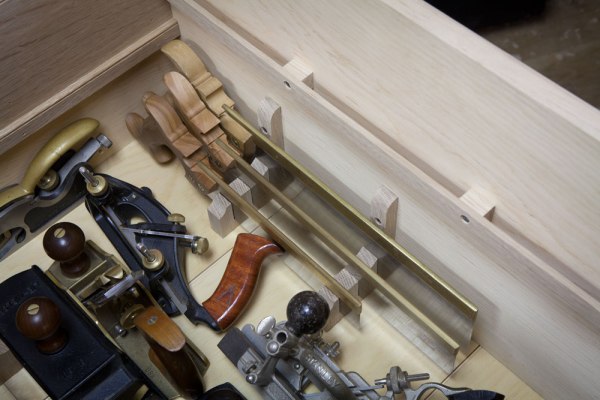
As you design your tool chest, a little bit of cypherin’ can make a tool chest seem like the Tardis – way bigger on the inside than it should be.
This traveling chest carries a remarkable amount of tools in its 28” long x 18” deep by 16” tall carcase because it imitates a lot of older tool chests I’ve observed. Those numbers above are one of the typical sizes you’ll see for a working chest (plus or minus a few inches here and there). Another set of common numbers is found in my Anarchist’s Tool Chest.
Where do these numbers come from? Our tools and our bodies, which is to say, from our bodies. The 28” length allows you to fit a long jointer plane and your panel saws inside – a critical dimension. The 18” depth is a standard depth for carcases, it also creates a box that one person can lift (ignoring the weight of the loaded chest for a moment).
The height? When this chest is complete with its lid it will be 18” tall. A square profile view is another standard form you’ll find in furniture, and it creates a stable case compared to a much taller carcase. I’ve also noticed how many chests seem to be divided into thirds along their vertical axis. The bottom third (about 6” or 7” of height) is for heavy tools such as bench planes, the big dinosaurs of our tool chest strata. The middle third (another 6”) is for the medium-sized tools in a big sliding till – braces, hand drills, some joinery planes and hammer. The top third is for the little bits, such as layout tools, knives, little planes and the like.

Today I finished fitting out the interior of this chest by adding a till for backsaws. I made it much like the till for the panel saws, except there are two bits of wood and the wood bits are wider because I want to hold three joinery saws.
The wooden holders are arranged so the saws can go into the rack either with their handles on the left or the right (I want them on the left so their horns are protected).
And yes, the wood is white oak – it’s what I have on hand after making the tills and runners. Several readers have questioned the wisdom of using oak because of its pH and tannin content. I’ve seen a lot of oak in old tool chests, and here is my reasoning:
If you use your tools and keep them wiped down with oil, like a responsible mechanick, you will not have a problem with corrosion. If you plan to store your tools for a long time without using them, consider Tupperware and rust-inhibiting paper. Wood is acidic. Period. But if you take care of your tools, oak isn’t going to give you any trouble.
Now I just have to turn the handles for the carcase and wait for the lid to arrive….
— Christopher Schwarz